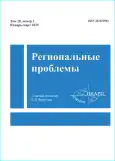State of the population marital structure as a factor of birth rate reduction in the Jewish Autonomous Region
- Autores: Komarova T.M.1, Stelmakh E.V.1, Solovchenkov S.A.1
-
Afiliações:
- Институт комплексного анализа региональных проблем ДВО РАН
- Edição: Volume 28, Nº 1 (2025)
- Páginas: 46-55
- Seção: DEMOGRAPHICS
- URL: https://journals.rcsi.science/1605-220X/article/view/302352
- DOI: https://doi.org/10.31433/2618-9593-2025-28-1-46-55
- EDN: https://elibrary.ru/PIJHOH
- ID: 302352
Citar
Texto integral
Resumo
The article deals with an urgent demographic problem in the Jewish Autonomous region, connected with the factor of population marital structure influence on a birth rate decrease. The study is relevant as the population marital structure state has an impact on the most important demographic processes – fertility, mortality and reproduction, and, eventually, on disintegration of the family as the main unit of the society. Based on divorce and marriage coefficients dynamic series comparative analysis, made by the authors for the Far Eastern Federal District regions in 1990-2022, it was registered the initial growth of the population, due to its natural growth, with the following return to natural decline. The Pearson correlation, used by the authors at the study, shows a direct interrelation between the number of marriages and the number of children born, in the Jewish Autonomous region. It is observed a great number of babies born out of wedlock. Though there is an inconsiderable trend towards this rate decrease, its value is still high – the fact that shows transformation of the marriage institution. Moreover, this indicator prevails in rural settlements with a much lower living standards of the population. There is a decrease in the fertility rate which leads to the showings far from providing a simple type of reproduction.
Since similar studies have not been conducted in the region, the presented materials demonstrate an intermediate result of this topic, which is in the research process, aimed at providing a deeper study of the demographic situation in the region.
Sobre autores
T. Komarova
Институт комплексного анализа региональных проблем ДВО РАН
Autor responsável pela correspondência
Email: carpi-komarova@yandex.ru
ORCID ID: 0000-0002-7876-4284
Rússia, ул. Шолом-Алейхема 4, г. Биробиджан, 679016
E. Stelmakh
Институт комплексного анализа региональных проблем ДВО РАН
Email: stelmahlena69@mail.ru
ORCID ID: 0000-0002-2060-8107
Rússia, ул. Шолом-Алейхема 4, г. Биробиджан, 679016
S. Solovchenkov
Институт комплексного анализа региональных проблем ДВО РАН
Email: solovchenkov@yandex.ru
ORCID ID: 0000-0003-2687-725X
Rússia, ул. Шолом-Алейхема 4, г. Биробиджан, 679016
Bibliografia
- Antonov G.V. Basic Trends in Marriage and Divorce in Russia over the Past 50–60 years. Natsional’nye interesy: prioritety i bezopasnost’, 2015, no. 4 (289), pp. 43–53. (In Russ.).
- Afasizhev T.I., Khrupin S.I. Family-marriage relations in modern sociocultural space of Russia: regional aspect. Vestnik Adygeiskogo gosudarstvennogo universiteta. Seriya 1: Regionovedenie: filosofiya, istoriya, sotsiologiya, yurisprudentsiya, politologiya, kul’turologiya, 2009, no. 2, pp. 60–68. (In Russ.).
- Bobkov V.N., Elizarov V.V., Dzhanaeva N.G., Danilova I.A., Malikov N.S., Sinitsa A.L. Methodological foundations for the development of regional demographic development programs taking into account regional characteristics (on the example of the Far Eastern Federal District). Uroven’ zhizni naseleniya regionov Rossii, 2013, no. 1 (179), pp. 10–17. (In Russ.).
- Gosudarstvennyi doklad o polozhenii detei i semei, imeyushchikh detei, v Rossiiskoi Federatsii za 2018 god. Available at: https://www.gov.spb.ru/static/writable/ckeditor/uploads/2020/01/15/10/2019.11.29_Mintrud_doklad_deti.pdf (accessed: 27.06.2024). (In Russ.).
- Darsky L.E., Ilyina I.L. Brachnost’ v Rossii. Analiz tablits brachnosti (Nuptiality in Russia. Analysis of nuptiality tables). Moscow: Informatika Publ., 2000. 144 p. (In Russ.).
- Demograficheskii ezhegodnik Evreiskoi avtonomnoi oblasti: stat. sb. (Demographic Yearbook of the Jewish Autonomous Region). Birobidzhan, 2019. 81 p. (In Russ.).
- Demograficheskoe razvitie Rossii: tendentsii, prognozy, mery. Natsional’nyi demograficheskii doklad – 2020, S.V. Ryazantsev, V.N. Arkhangel’skii, O.D. Vorob’eva et al.; S.V. Ryazantsev Ed. Moscow: Ob”edinennaya redaktsiya Publ., 2020. 156 p. (In Russ.).
- Zakharov S.V. Potentsial strukturnykh faktorov rosta rozhdaemosti ischerpan? Ch. 2. Demoskop Weekly, 2017, no. 733–734. Available at: http://demoscope.ru/weekly/2017/0733/tema01.php (accessed: 22.06.2024). (In Russ.).
- Komarova T.M. Modern Trends in the Birth Rate in Jewish Autonomous Region. Regional’nye problemy, 2017, vol. 20, no. 4, pp. 103–107. (In Russ.).
- Komarova T.M., Kalinina I.V., Mishchuk S.N. Sociodemographic security of a border region: a case study of Jewish Autonomous oblast, in Voprosy geografii. Sb. 141: Problemy regional’nogo razvitiya Rossii (Problems of geography. no. 141: Problems of Regional Development of Russia). Moscow: Kodeks Publ., 2016, pp. 578–595. (In Russ.).
- Neverova G.P. Analysis of Birth Rates, Marriages and Divorces Dynamics (by the Example of the Jewish Autonomous Region). Regional’nye problemy, 2009, no. 12, pp. 73–77. (In Russ.).
- Operativnye demograficheskie pokazateli Evreiskoi avtonomnoi oblasti: yanvar’-mai 2023. Available at: https://27.rosstat.gov.ru/storage/mediabank/Operativnye%20demograficheskie%20pokazateli%20za%20yanvar’-mai%202023%20goda_EAO.pdf (accessed: 21.06.2024). (In Russ.).
- Pirozhkov S.I. Demograficheskie protsessy i vozrastnaya struktura naseleniya (Demographic processes and the age structure of the population). Moscow: Statistika Publ., 1976. 135 p. (In Russ.).
- Regiony Rossii. Sotsial’no-ekonomicheskie pokazateli. 2015: stat. sb. (Regions of Russia. Socio-economic indicators. 2015: statistical collection). Moscow: Rosstat Publ., 2015. 1266 p. (In Russ.).
- Regiony Rossii. Sotsial’no-ekonomicheskie pokazateli. 2021: stat. sb. (Regions of Russia. Socio-economic indicators. 2021: statistical collection). Moscow: Rosstat, 2021. 1112 p. (In Russ.).
- Rosstat. Prilozhenie k demograficheskomu ezhegodniku Rossii 2015 g. Available at: https://rosstat.gov.ru/storage/mediabank/demo15.rar (accessed: 21.06.2024). (In Russ.).
- Rosstat. Prilozhenie k demograficheskomu ezhegodniku Rossii 2019 g. Available at: https://rosstat.gov.ru/storage/mediabank/pril-dem19.rar (accessed: 21.06.2024). (In Russ.).
- Rosstat. Prilozhenie k demograficheskomu ezhegodniku Rossii 2023 g. Available at: https://rosstat.gov.ru/storage/mediabank/Pril_Demogr_ejegodnik_2023.xls (accessed: 21.06.2024). (In Russ.).
- Sinel’nikov A.V. The influence of marriage on fertility and demographic policy in Russiai. Sem’ya i sotsial’no-demograficheskie issledovaniya, 2015, no. 4, pp. 1–17. Available at: https://istina.msu.ru/publications/article/9258450/ (accessed: 21.06.2024). (In Russ.).
- Sinitsa A.L. Marriage and divorce trends in the Far Eastern federal district in 1990-2015. Izvestiya Russkogo geograficheskogo obshchestva, 2017, vol. 149, no. 5, pp. 81–95. (In Russ.).
- The number of women per 1000 men in the Jewish Autonomous Region. Upravlenie Federal’noi sluzhby gosudarstvennoi statistiki po Khabarovskomu krayu, Magadanskoi oblasti, Evreiskoi avtonomnoi oblasti i Chukotskomu avtonomnomu okrugu. Available at: https://27.rosstat.gov.ru/folder/25658 (accessed: 22.08.2024). (In Russ.).
- Sherifova A.F., Ibragimova A.Sh., Dadaeva B.Sh. Marriage and Divorce Rates in Russia and its Regions in Dynamics. Regional’nye problemy preobrazovaniya ekonomiki, 2021, no. 1, pp. 98–104. (In Russ.).
Arquivos suplementares









